| Posted: Apr 10, 2018 |
Cheaper, less toxic and recyclable light absorbers for hydrogen production
(Nanowerk News) Mimicking photosynthesis in plants, using light to convert stable and abundant molecules like water and CO22 into a high energy fuel (hydrogen) or into chemicals of industrial interest, is a major research challenge today. However, achieving artificial photosynthesis in solution remains limited by the use of costly and toxic metal-based compounds to harvest light.
|
|
Researchers at CNRS, CEA and the Université Grenoble Alpes propose an efficient alternative using semi-conductor nanocrystals (also called quantum dots) based on cheaper and less toxic elements, such as copper, indium and sulfur. Their work was published in Energy & Environmental Science ("Cadmium-Free CuInS2/ZnS Quantum Dots as Efficient and Robust Photosensitizers in combination with a Molecular Catalyst for Visible Light-Driven H2 Production in Water").
|
 |
| Hybrid systems for hydrogen production using solar energy. (Image: Damien Jouvenot, Département de Chimie Moléculaire (CNRS/Université Grenoble Alpes)
|
|
In artificial photosynthesis systems chromophores, or "photosensitizers", absorb light energy and transfer electrons to the catalyst, which activates the chemical reaction. Although much progress has been made in recent years in the development of catalysts devoid of noble metals, photosensitizers still rely, in the main, on molecular compounds containing rare and costly metals, such as ruthenium and iridium, or on inorganic semiconductor materials containing cadmium, a toxic metal.
|
|
For the first time, researchers at the Département de Chimie Moléculaire (CNRS/Université Grenoble Alpes) and SyMMES (CNRS/CEA/Université Grenoble Alpes) have demonstrated, by joining their expertise in semiconductor engineering and photocatalysis, that it is possible to produce hydrogen very efficiently by combining inorganic semiconductor nanocrystals (quantum dots) formed of a copper and indium sulfide core protected by a zinc sulfide shell, with a cobalt-based molecular catalyst.
|
|
This "hybrid" system combines the excellent visible light absorption properties and the great stability of inorganic semiconductors with the efficacy of molecular catalysts. In the presence of excess vitamin C, which provides electrons to the system, it shows remarkable catalytic activity in water, the best obtained to date with cadmium-free quantum dots.
|
|
This system's performance is much higher than that obtained with a ruthenium-based photosensitizer, due to the very high stability of inorganic quantum dots, which can be recycled several times without notable loss of activity.
|
|
These results show the high potential of such hybrid systems for hydrogen production using solar energy.
|

